What Has Changed…? The New Oris Aquis Date Compared to the Old Model
It's a real "spot the difference" game but in the end, it's recipe that has often proven effective.
Evolution, not revolution. It’s a well-known strategy that has been applied by so many brands, and not just in the watch industry. The idea of gradually updating/upgrading your most emblematic product without drastically changing it is at the heart of the success of icons such as the Porsche 911, the iPhone, the Nike Air Max and, of course, watches such as the Submariner or the Speedmaster. With the idea of maintaining the emblematic status of a watch, but also improving what can be improved, Oris is applying this evolution-driven strategy to its best-seller dive watch, the contemporary Aquis Date collection. What’s new? What has changed? What has been kept? We have a closer look at this in our latest video review and in this article.
What has changed in a nutshell
Because the differences between the new Oris Aquis Date and the old model are visually hard to spot for a non-trained eye, here’s a quick summary of what to expect with the 2024 collection, before we move to a more detailed overview.
- A complete collection with 4 different sub-families
- 43.5mm case with manufacture Calibre 400, available in blue, green or recycled PET plastic dial
- 43.5mm case with Calibre 733 (Sellita), available in green, blue, black or recycled PET plastic
- 41.5mm case with Calibre 733 (Sellita), available in green, blue, black or recycled PET plastic
- 36.5mm case with Calibre 733 (Sellita), available in black, cream mother-of-pearl or recycled PET plastic
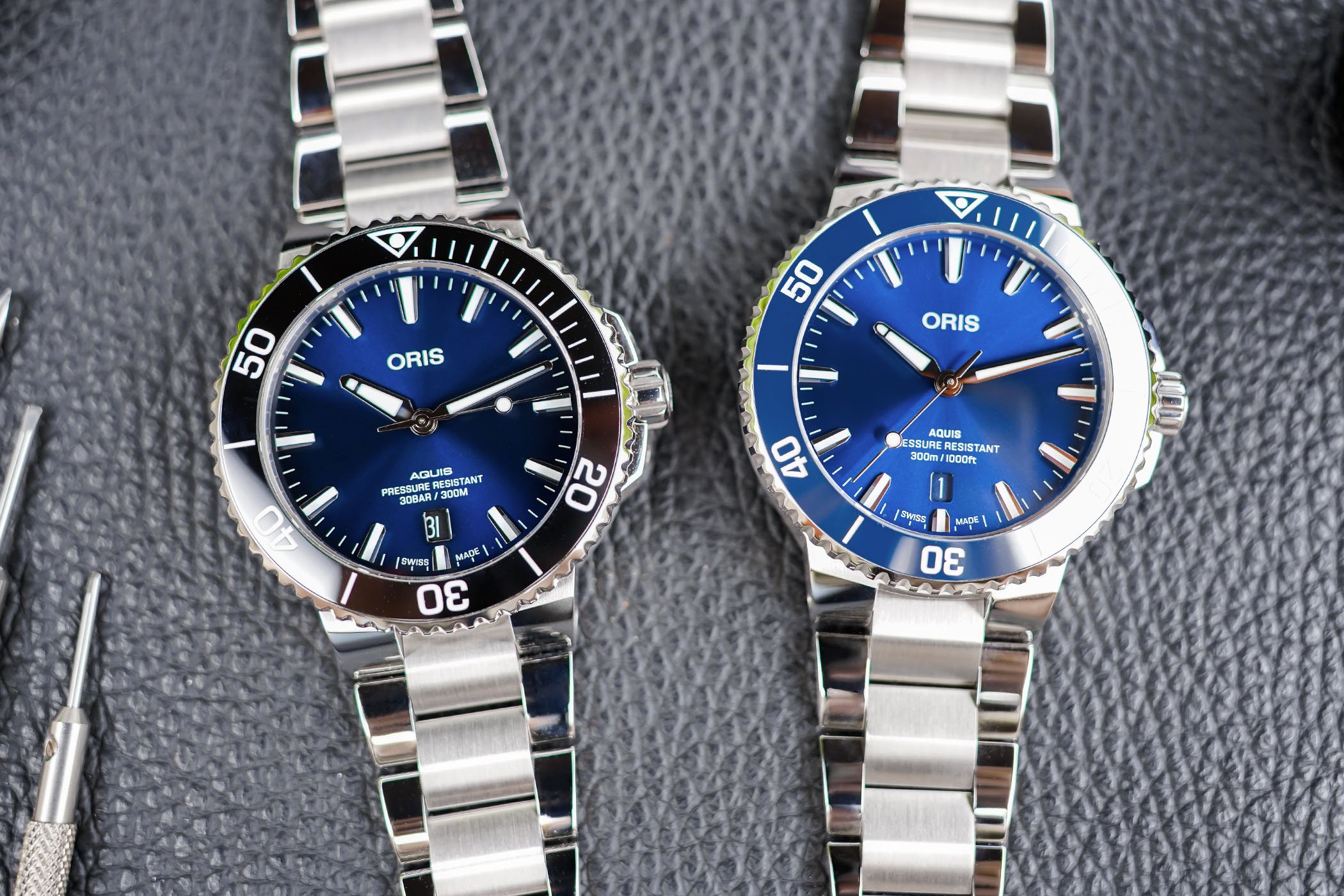
- Slimmer cases for all the models – about 0.5mm less than before
- Subtle design updates for the case
- slightly slimmer, more tapered lugs, with a more sloped profile
- more tapered and more rounded crown guards
- re-proportioned ceramic bezel with an updated notched profile
- slightly more pronounced bevel on the caseback
- Lightly updated dials
- reshaped shield-like hour markers
- updated hands with new luminous insert
- more compact font for the text
- colour-matched date disc on all models

- Reshaped bracelet
- broader central link and connection link
- more taper from the case to the clasp
- patented quick-change system only on the Calibre 400
- quick-adjust clasp only on the Calibre 400
The Details about the new Oris Aquis Date
As you can see from our video review on top of this article, as well as the photos and the summary above, a lot has changed without changing much… Looking at the new Oris Aquis Date next to the old version is certainly the only way for someone not entirely familiar with the watch to spot the differences. New and old look very similar at a glance, but do they feel the same? Answer to come in a few. What matters is this: why change a watch that has proven enduring and appreciated by enthusiasts, specifically when it is one of the brand’s best-sellers? Why erasing the past with something new when Oris could simply look at its watch with a critical eye and focus on what can be improved, to make the Aquis better than it was?
Evolution… Not revolution. A proven recipe that aims at creating long-lasting icons
This was the solution chosen by Oris, and a strategy that we’ve seen applied on many of the most enduring timepieces on the market. Was the Aquis Date perfect? Surely not. Nothing is. Was there room for improvement? Yes, always. With this in mind, Oris has decided to keep the overall design and technical specifications alive, while upgrading what could be improved. This strategy ensures continuity while making sure that owners of the previous generation don’t feel aggrieved by a new watch that would make their cherished acquisition feel outdated and out of fashion. Continuity is key to creating a timeless, iconic collection. Period.
We’ve quickly been over the details and the evolution of the Oris Aquis Date in a dedicated article already, which you can read here. But let’s dive into the details. As said above, the Oris Aquis Date evolution has been released across the entire range, from the large 43.50mm with 5-day manufacture calibre, to its equally-sized sibling with Sellita movement, to a more compact 41.50mm model and a feminine option with a rather different look – not covered here. The only missing piece of the puzzle is the mid-size model, with a 39.50mm diameter. It’ll surely come.
Let’s start with the case, which feels identical at first but actually is entirely new. And it’s all about proportions, shapes and some work done on refinement. Whether we look at the 43.50mm or the 41.50mm versions, Oris has shaved about half a millimetre in thickness, respectively at 13.1mm and 12.9mm, versus 13.7mm and 13.3mm. This is mostly done thanks to a newly shaped caseback and combined with a central case that’s slightly thinner – the thickness has been redistributed between the central case and the caseback.
Next, the new Oris Aquis Date has thinner, more tapered lugs, on both plans. From the side, you can see that the lugs are thinner and have a more curved profile, with a more pronounced slope from the bezel to the tip with its screw. From the top, the profile is also more tapered and the central link is broader, giving a lighter feel to the whole watch. That being said, the Aquis is still a solid, contemporary dive watch with a certain heft. As for the crown guards, an identical recipe has been applied, as it is now slightly smaller and more tapered. Overall, minor updates that bring better ergonomics and a more refined look, without compromising the instrument-like design.
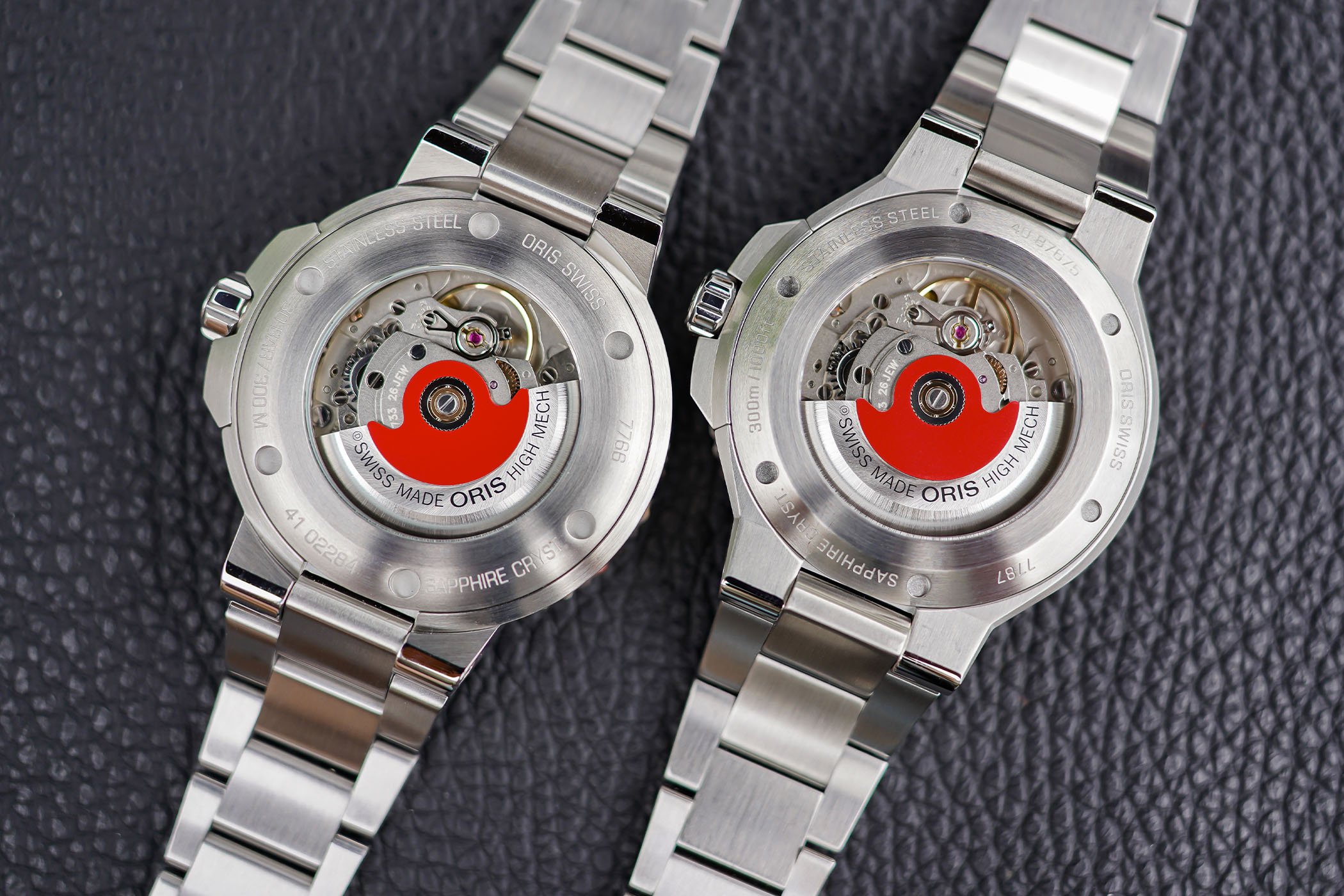
The final update concerning the exterior of the watch is about the bezel, which has been slightly proportioned, with a marginally thinner insert, a scale using thinner markers and numerals and a notched profile that feels better defined – the machining of the notches is more precise, as you can see in the photos.
Moving to the dial, the signature look of the Oris Aquis Date remains intact, yet with again minor upgrades to bring a more qualitative feel and more refinement. The shield-like hour markers have been lightly reshaped alongside the hands, with better definition and more precision in applying the luminous material. The dial now has its own dedicated fond (only used on the Aquis) that is a bit more compact. Finally, while it was already the case for some previous editions of the Aquis, now all models feature a colour-matched date wheel.
For its new Aquis Date, Oris has also reworked the stainless steel bracelet (rubber straps are also available, in colours matching the dial). What matters here is again about redistributing the size of all elements. First, the central brushed link is now broader, with the lateral polished links being thinner. Second, the bracelet has a more tapered profile from the case to the clasp. The higher-end model, the Aquis Date 43.50mm Calibre 400, comes equipped with two highly practical features; the patented quick-change system and the patented quick-adjust clasp system. In all fairness, it’s a bit of a missed opportunity not to have these two features across the entire range, even though it might have increased the price of the Sellita-based versions ever so slightly.
Regarding the movement, no evolutions to note. The range-topping model comes with the Calibre 400, an in-house developed automatic movement with modern features – 5-day power reserve, anti-magnetic silicon escape wheel and anchor, accuracy of -3/+5 seconds/day and 10-year warranty and 10-year recommended service intervals. There’s no denying the additional value of this movement compared to the Sellita-based Calibre 733. It is more powerful and more precise, but also more expensive – EUR 3,700 vs EUR 2,400.
With this in mind, there’s nothing wrong with the 733. It is a tried-and-tested SW200-1 automatic movement that will do the job with enough precision and reliability. In fact, on a personal level, my pick from the collection would be the 41.5mm model, which is for now only available with this movement. Knowing that the Aquis 41.50mm Calibre 400 has existed in the past, I don’t see why it wouldn’t make a comeback soon.
Conclusion
In short, the new Oris Aquis Date collection is a better watch on all levels. Surely, we’re talking about incremental, minor updates that do not reinvent the wheel. But looking closely at these new references, you can feel the difference. It’s a slightly more refined, better defined, more ergonomic, more contemporary and more qualitative watch on all levels. Oris has managed the perfect balance between upgrading a watch without making the older versions obsolete. It’s a clever move… A move that ensures continuity, enduring power and respect for the existing fan base. And it all comes with a marginal price increase of about EUR 100… We believe here at MONOCHROME that this is a fine strategy.
For more details, please visit www.oris.ch.

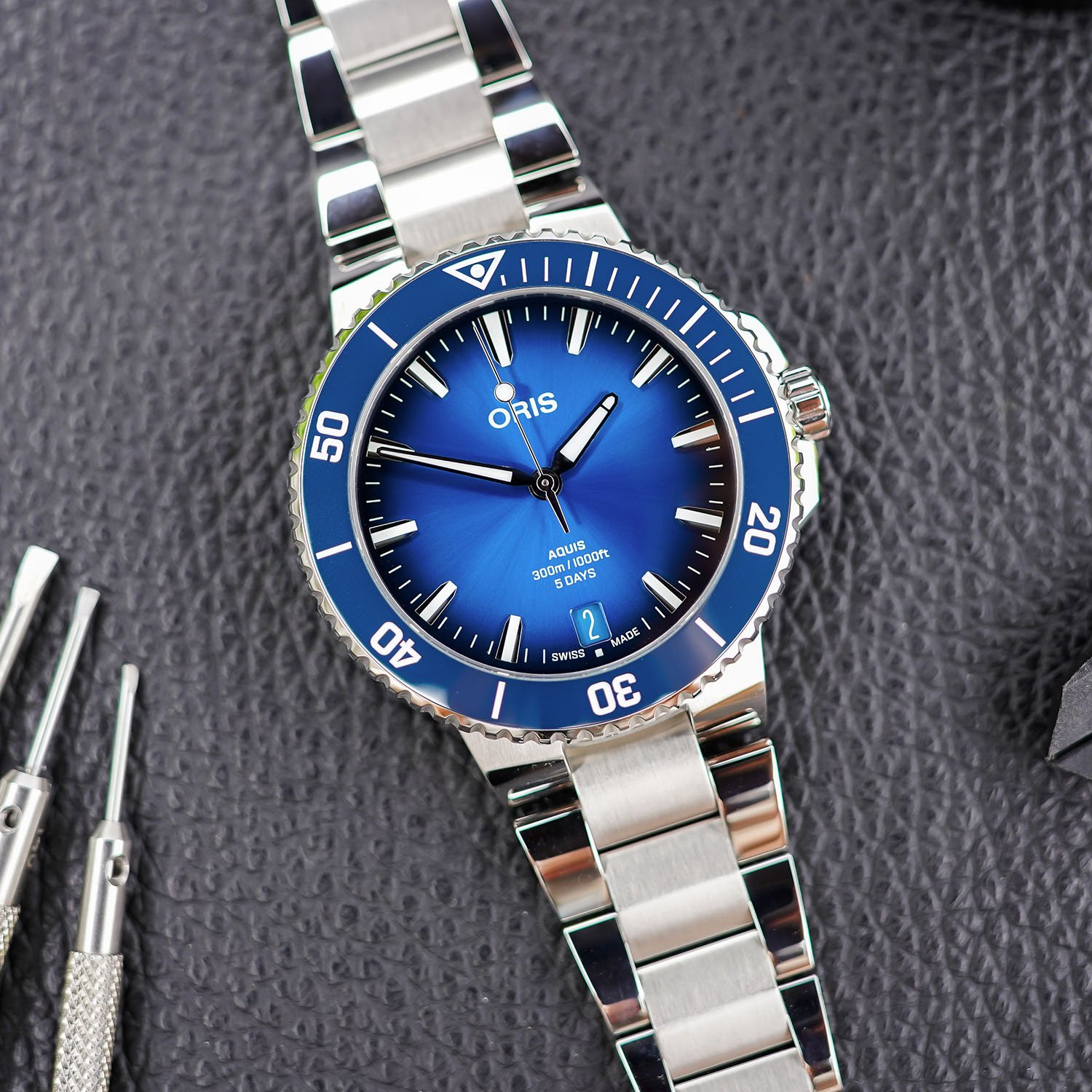
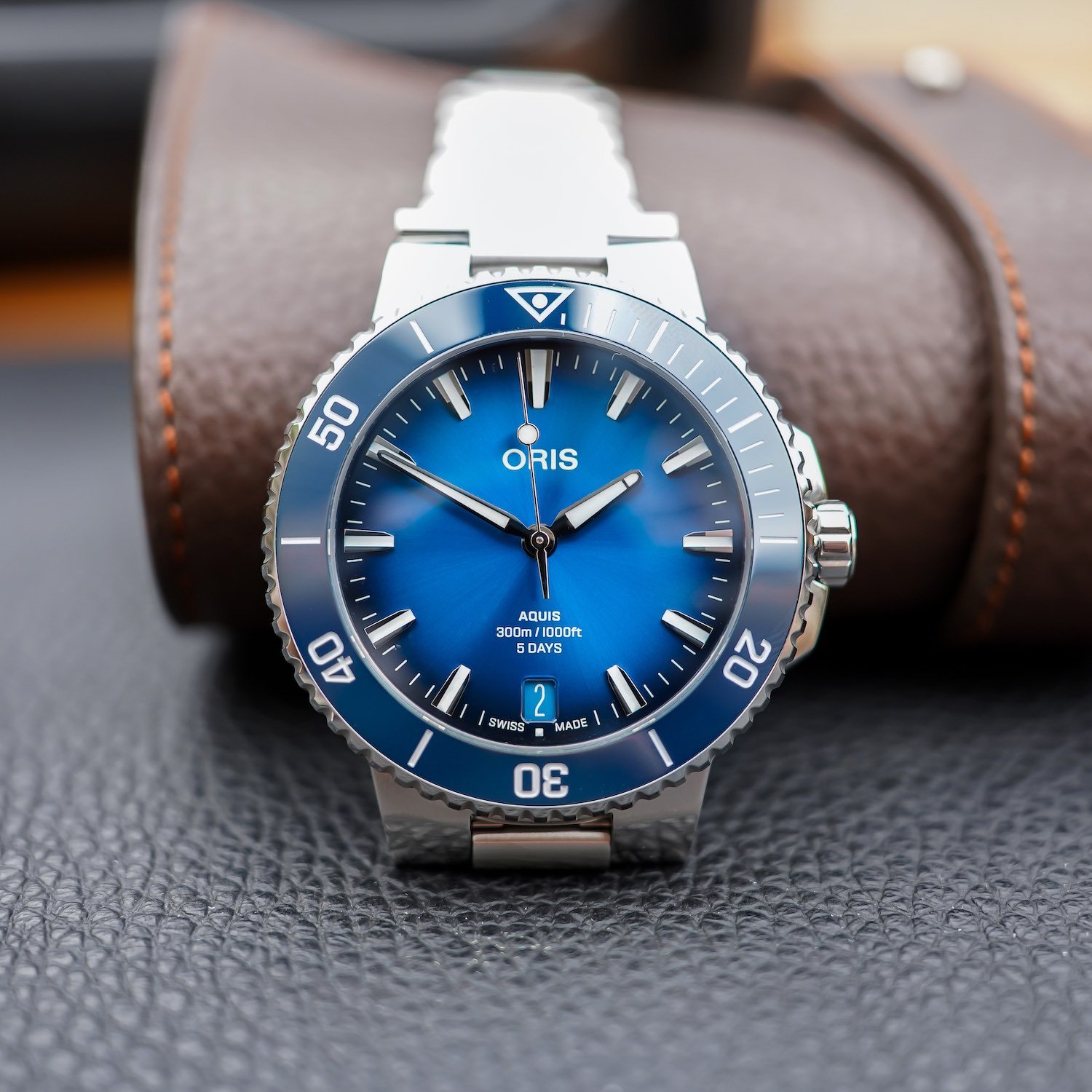
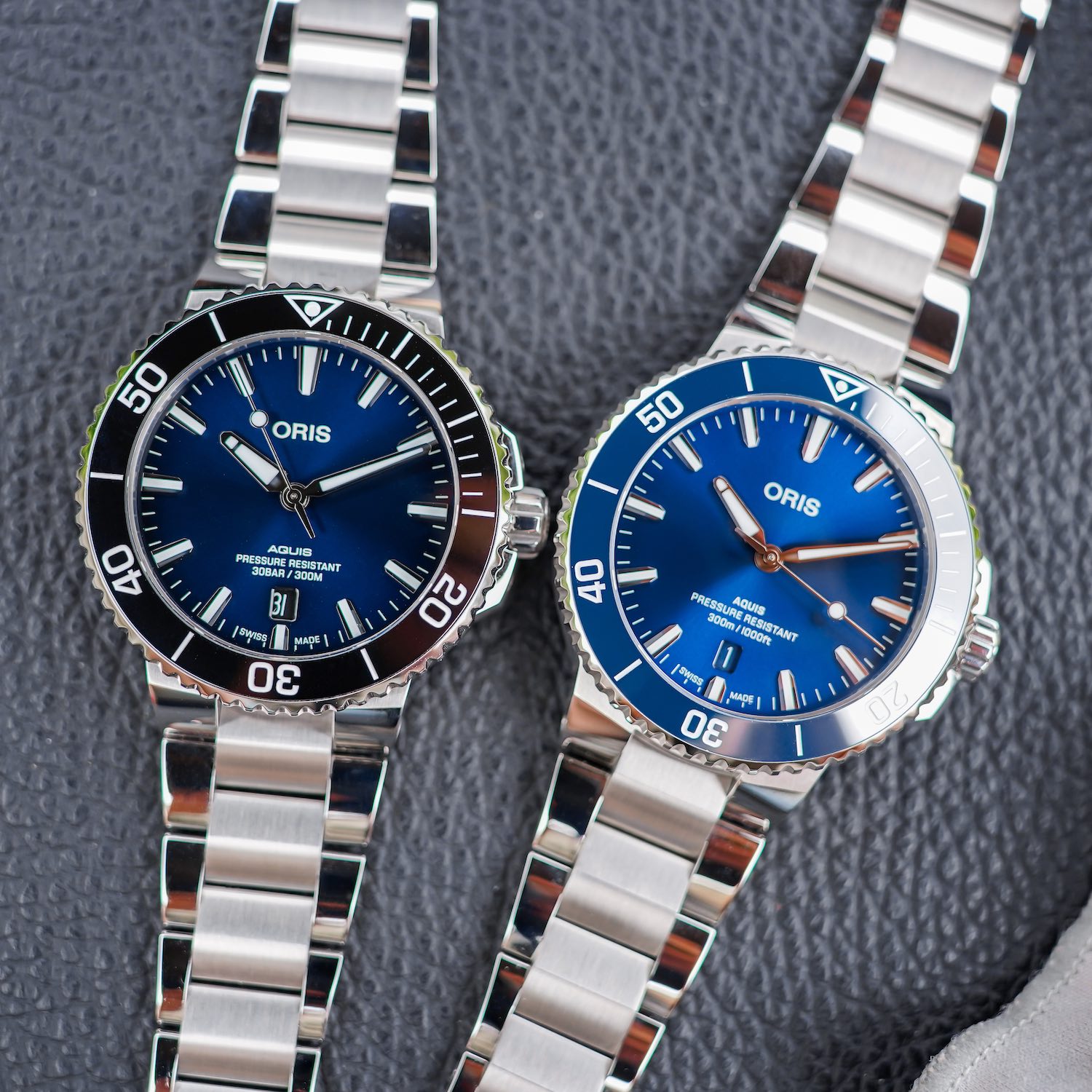
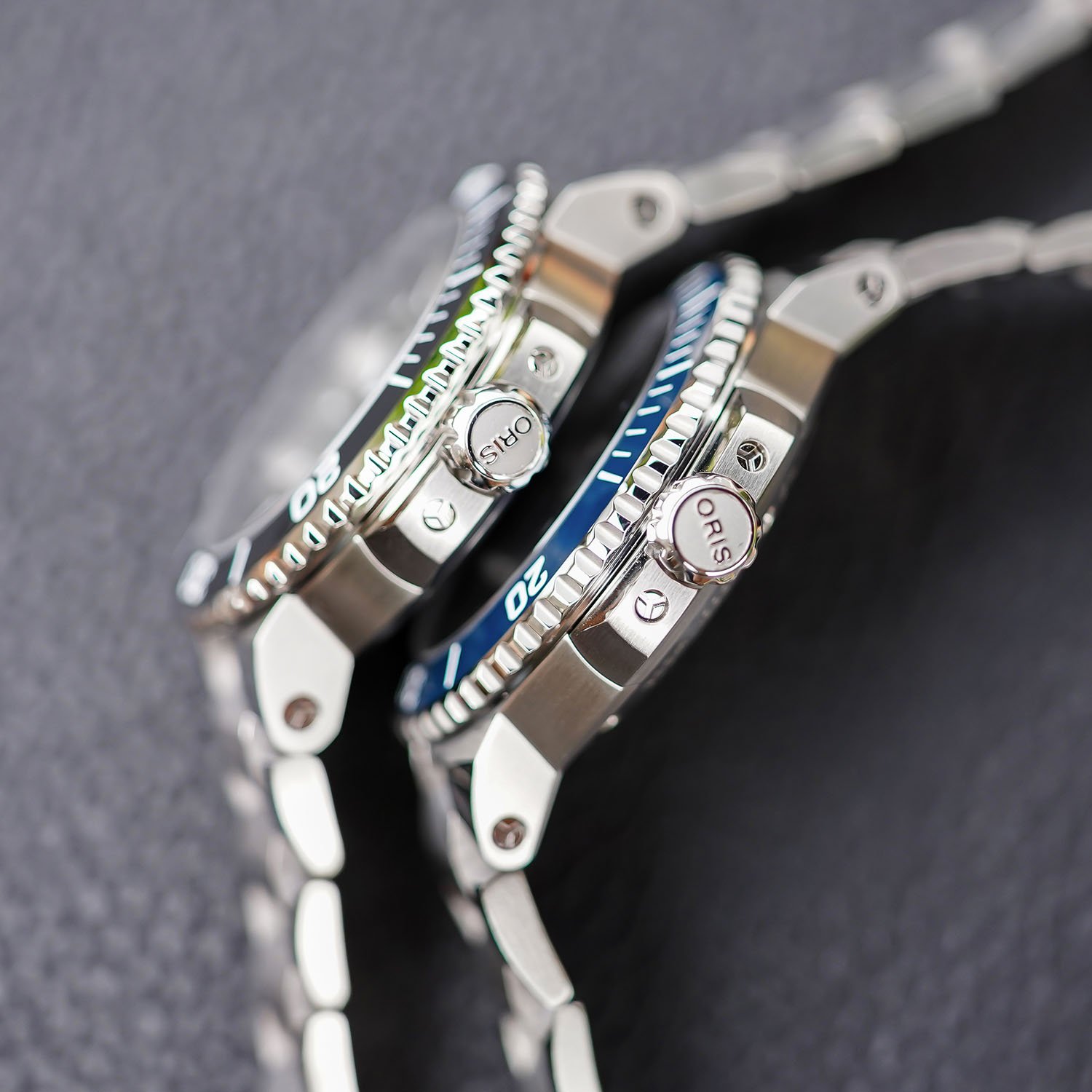
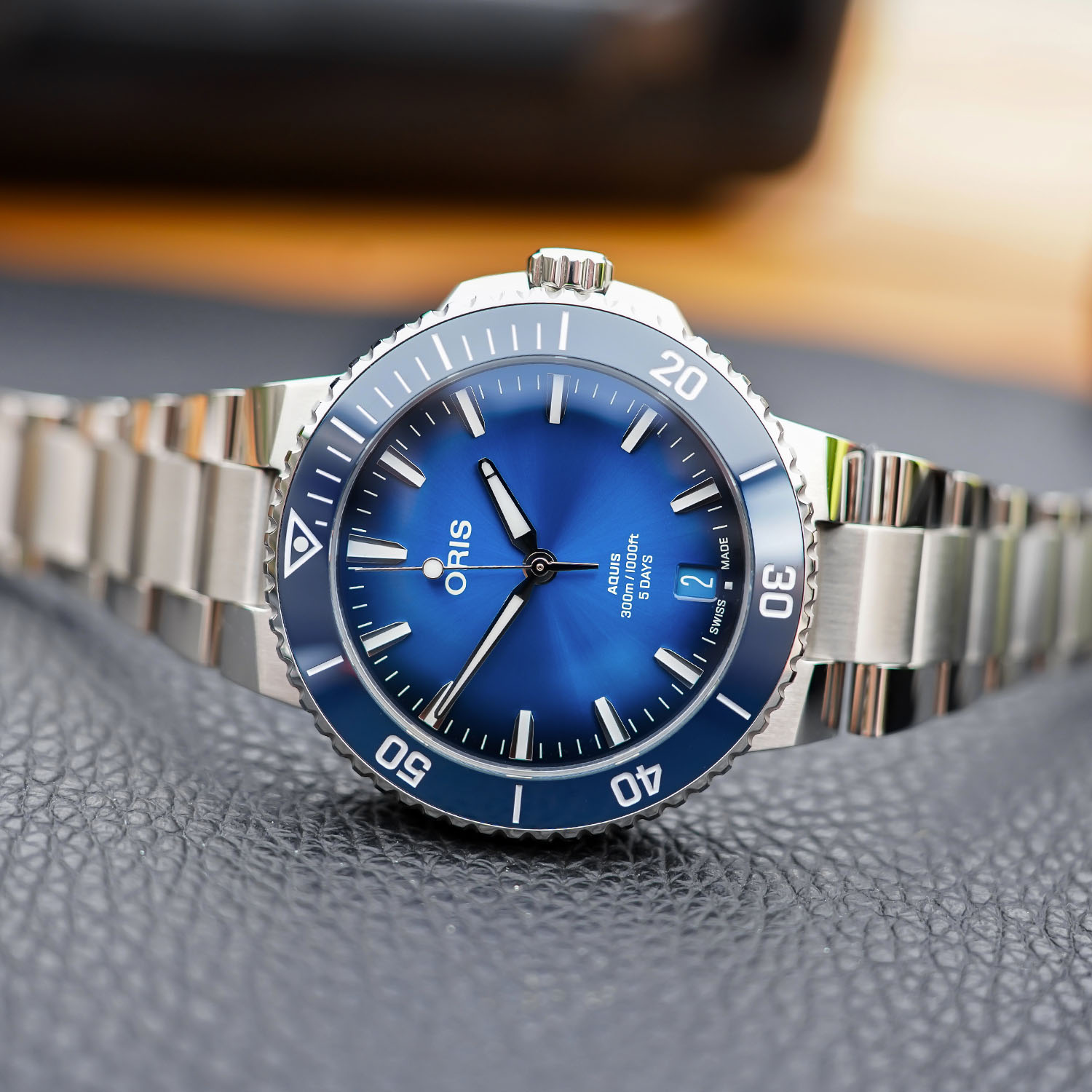
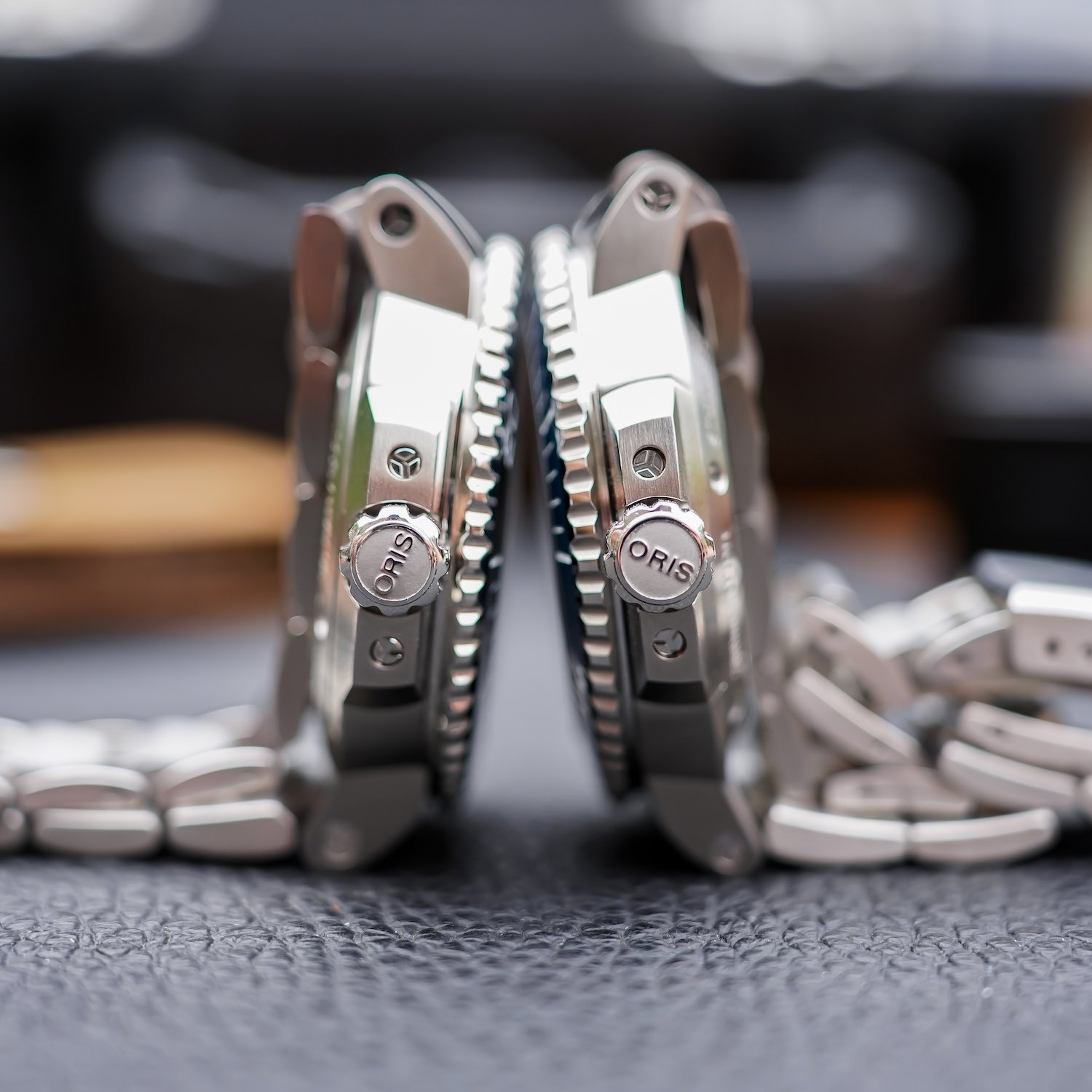
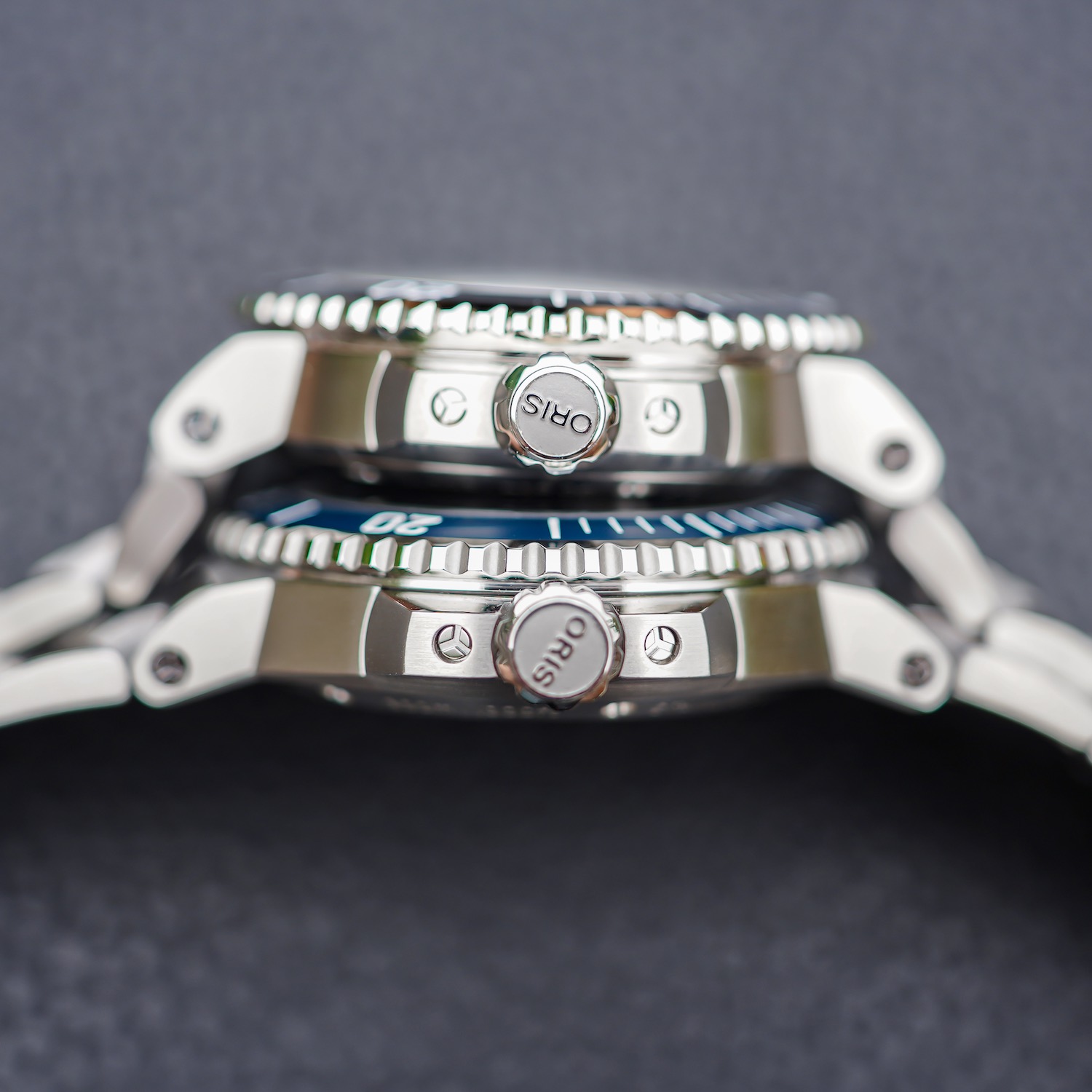
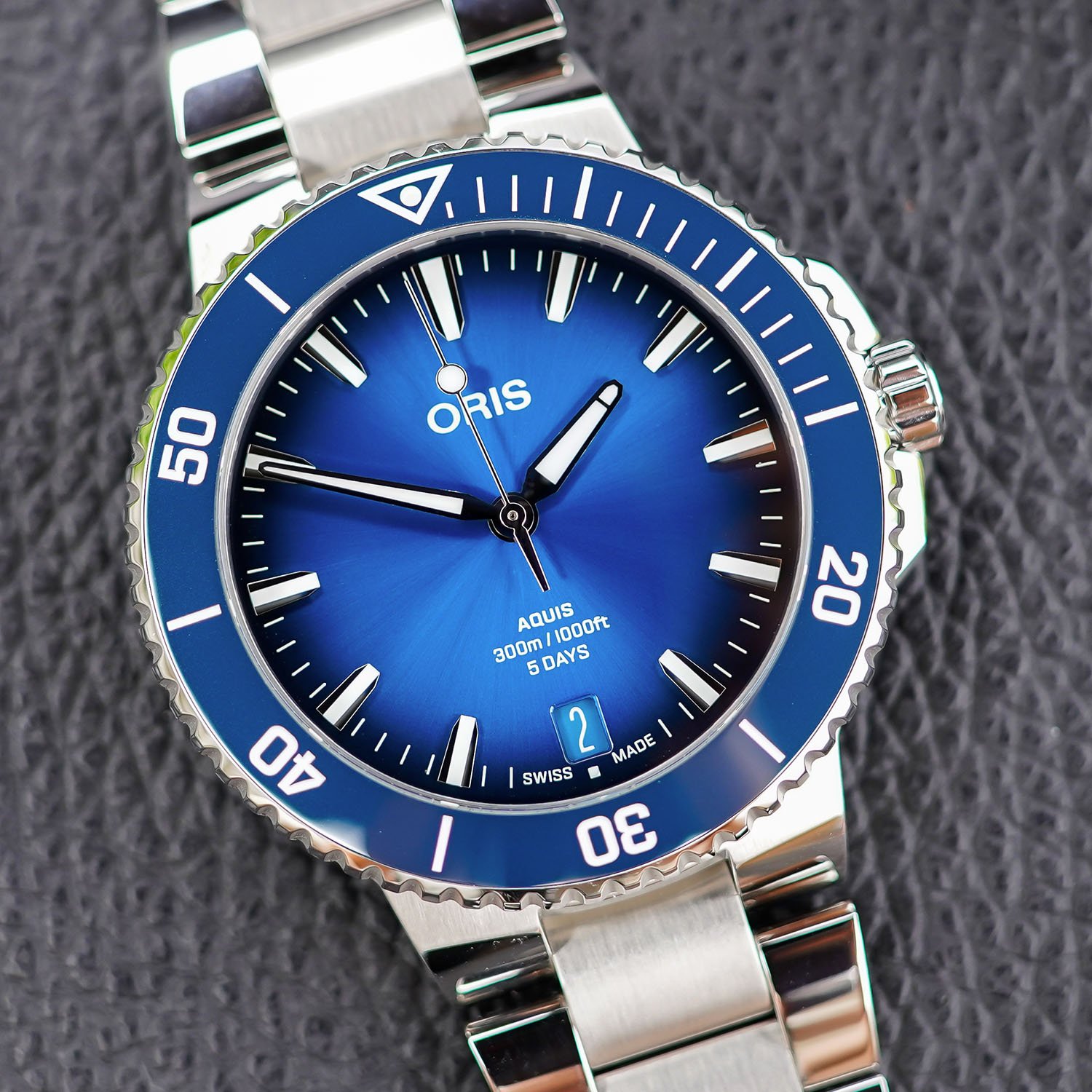
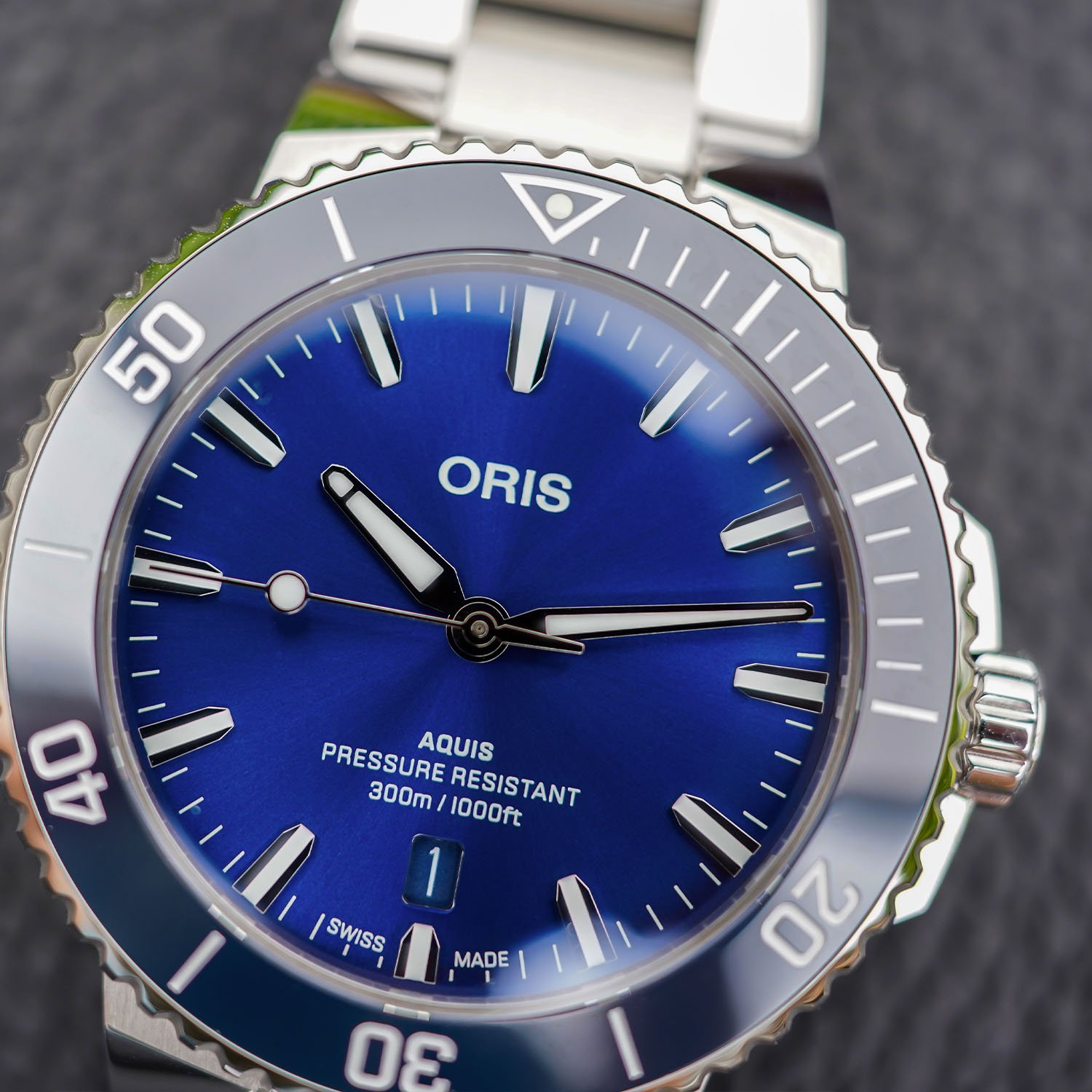
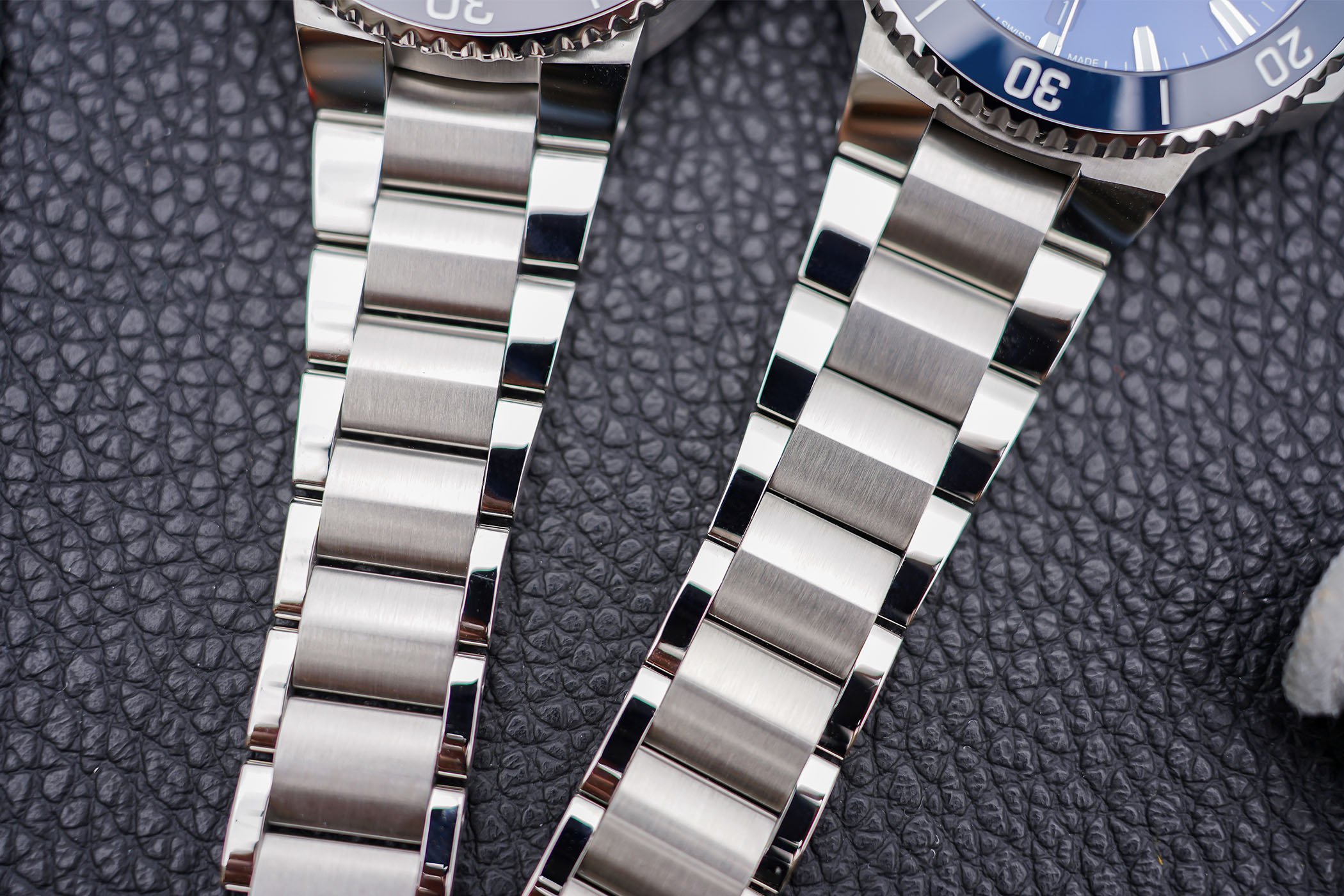
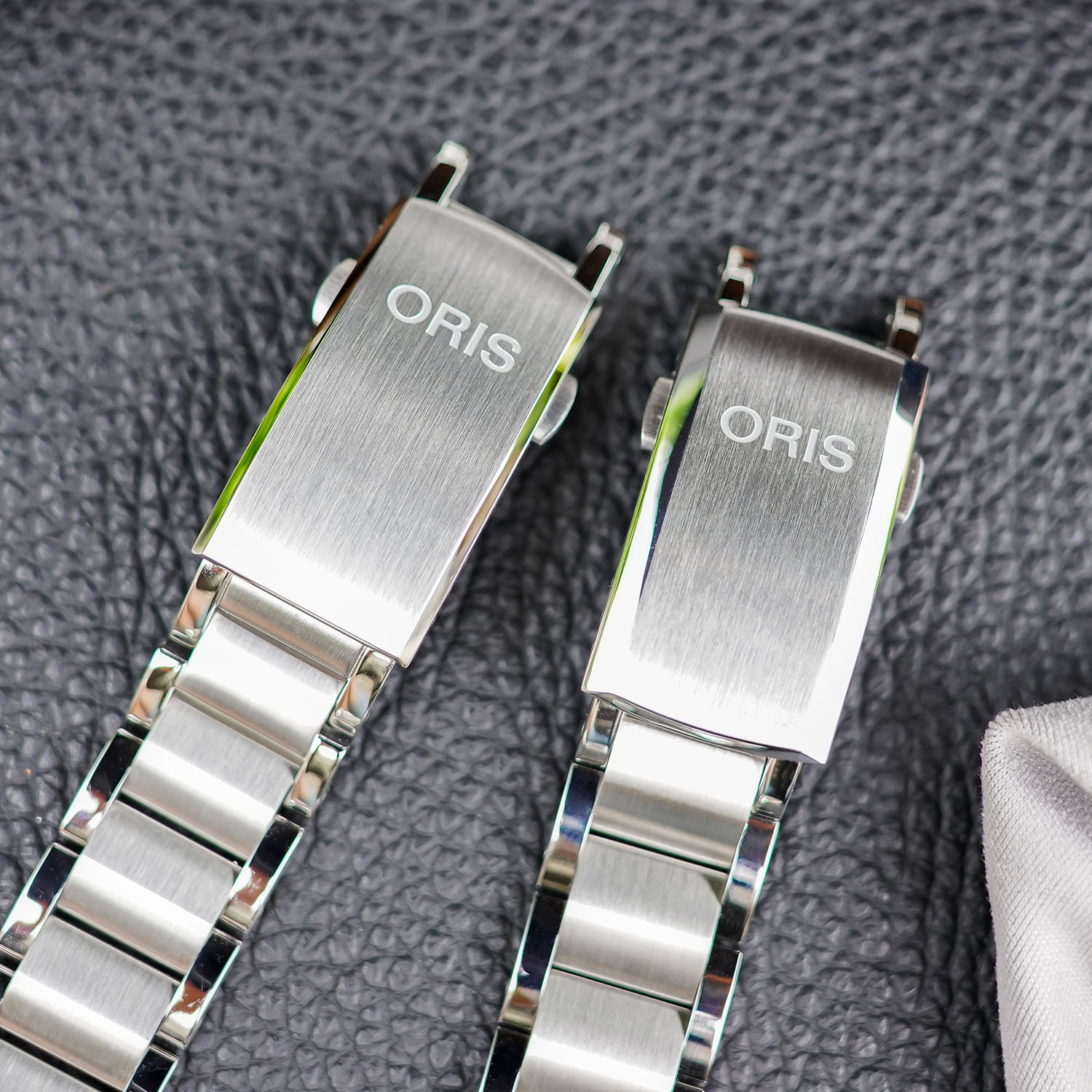
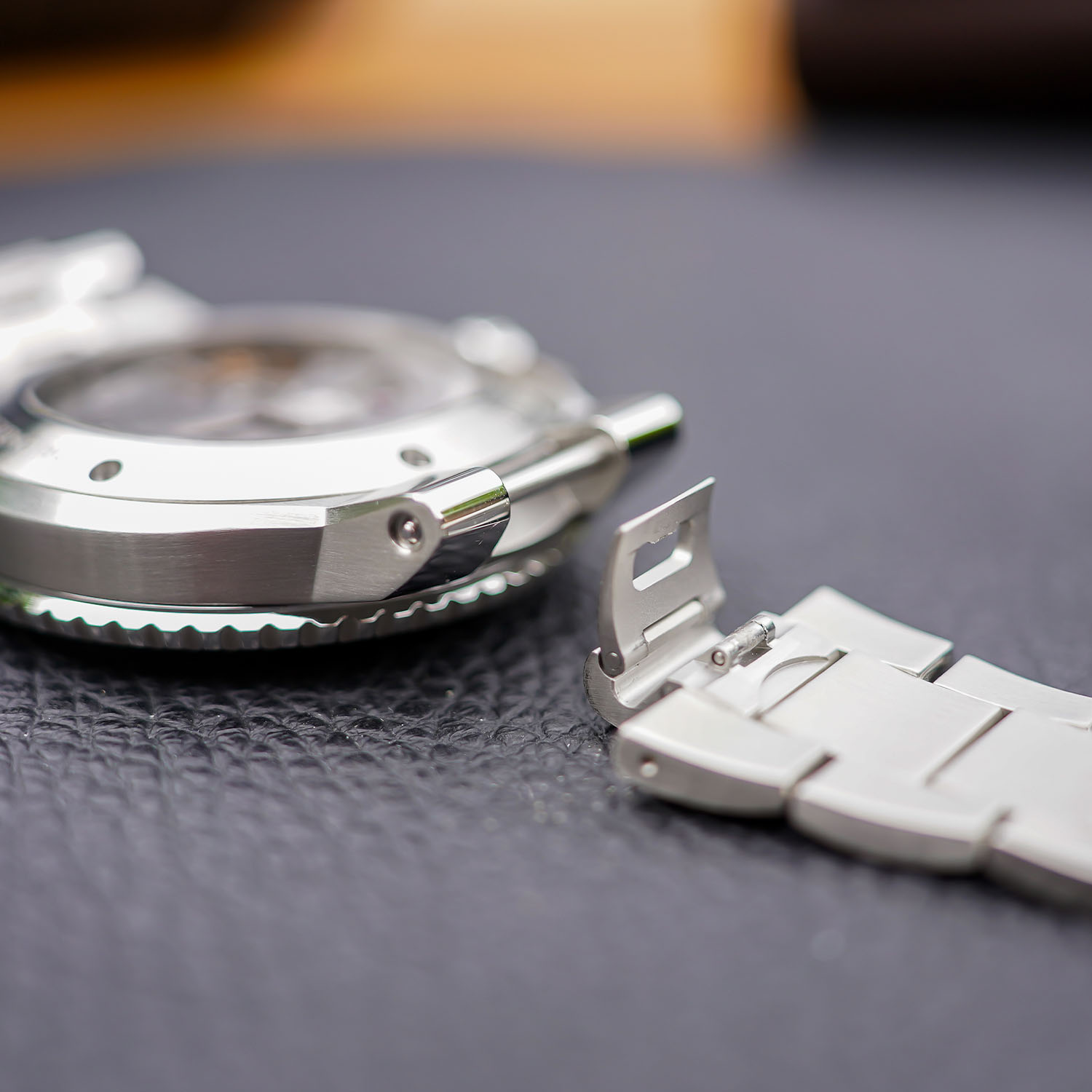
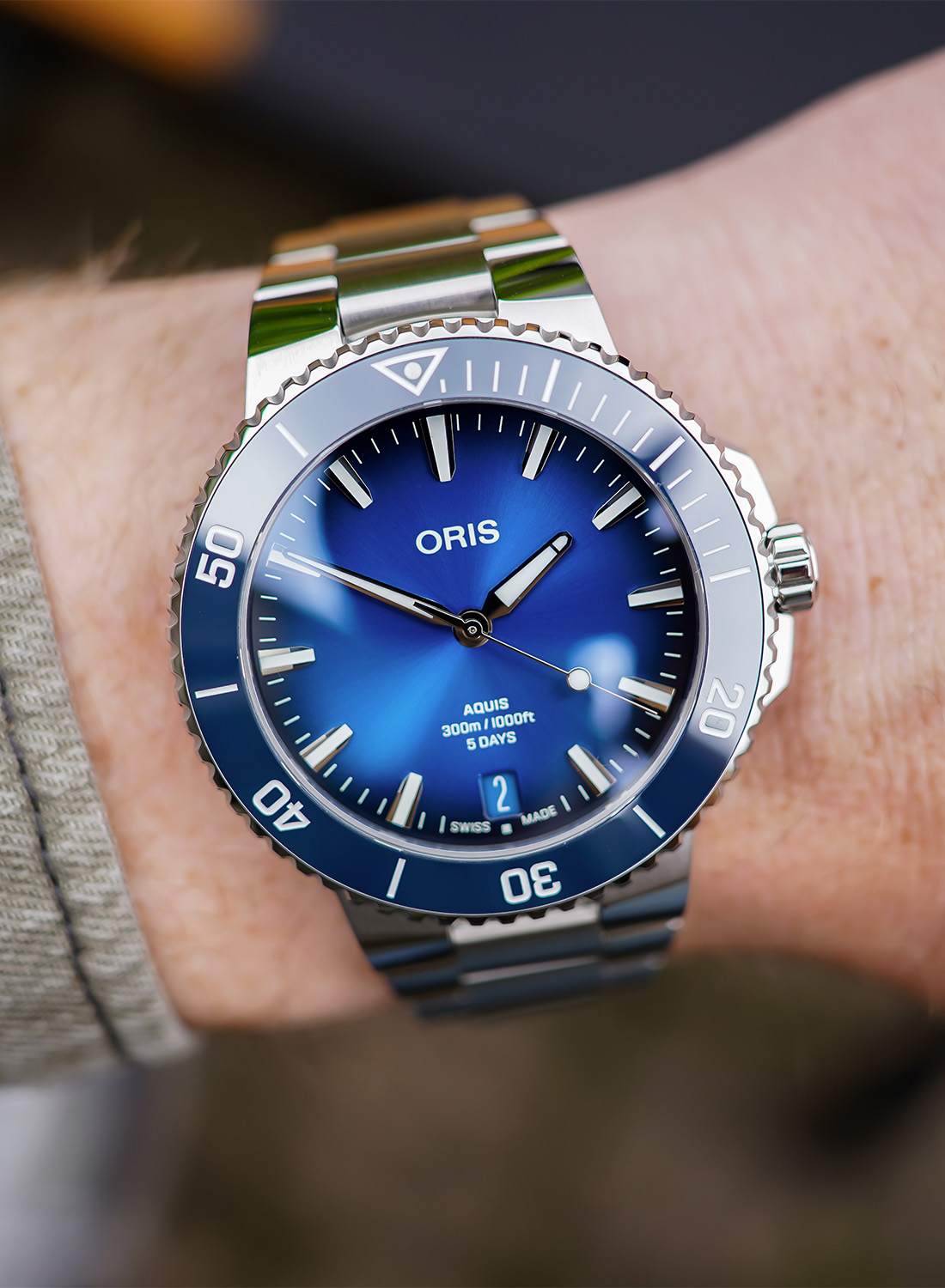
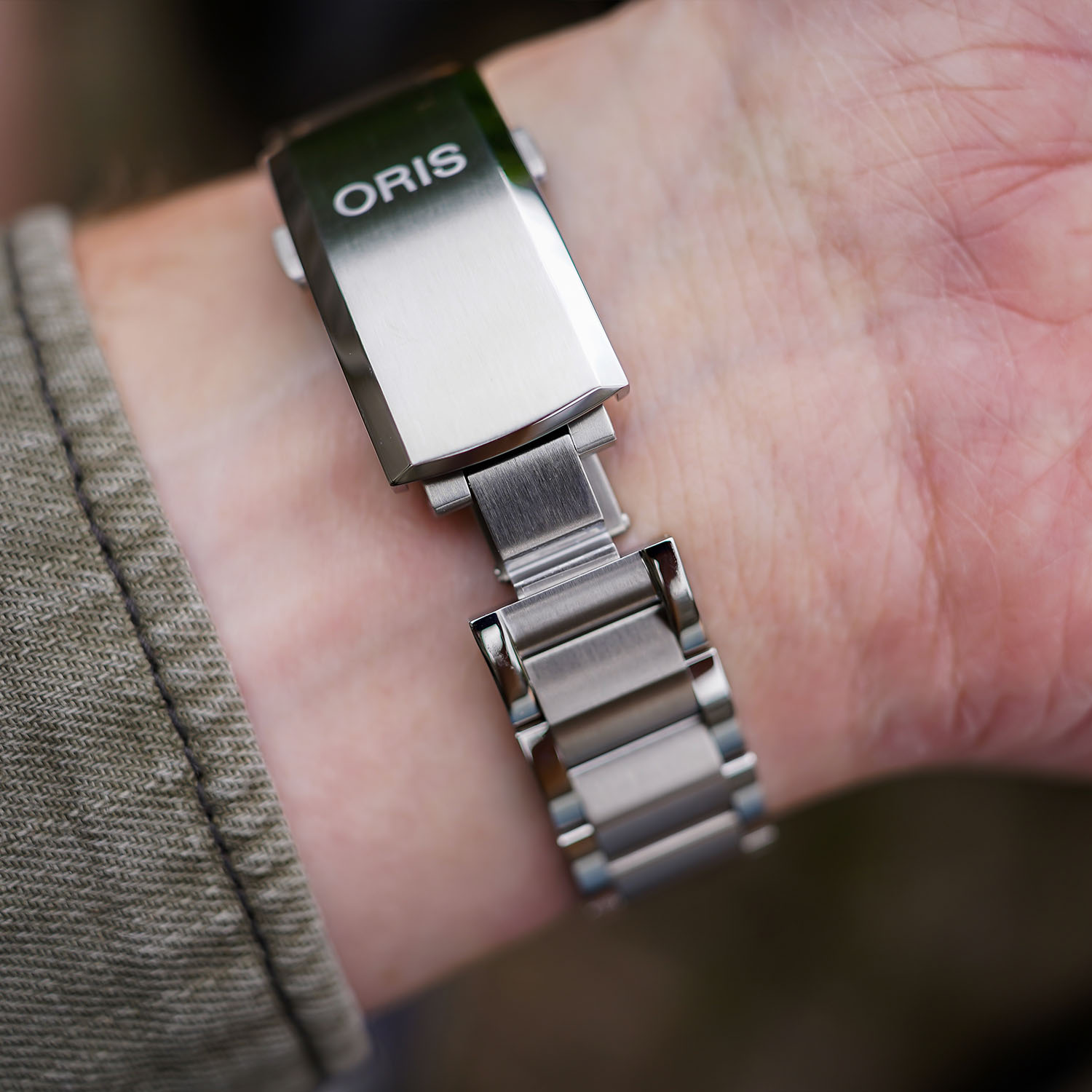
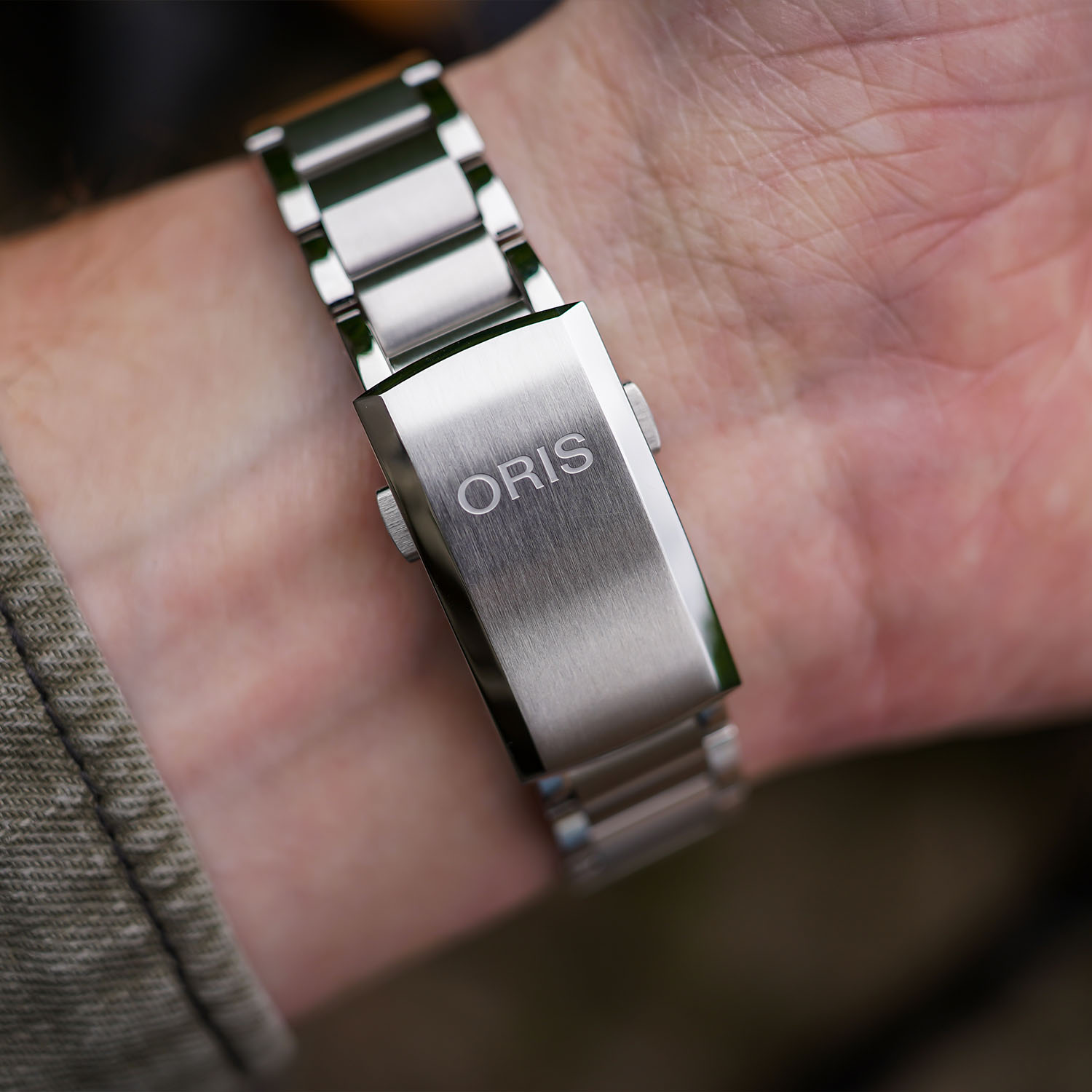
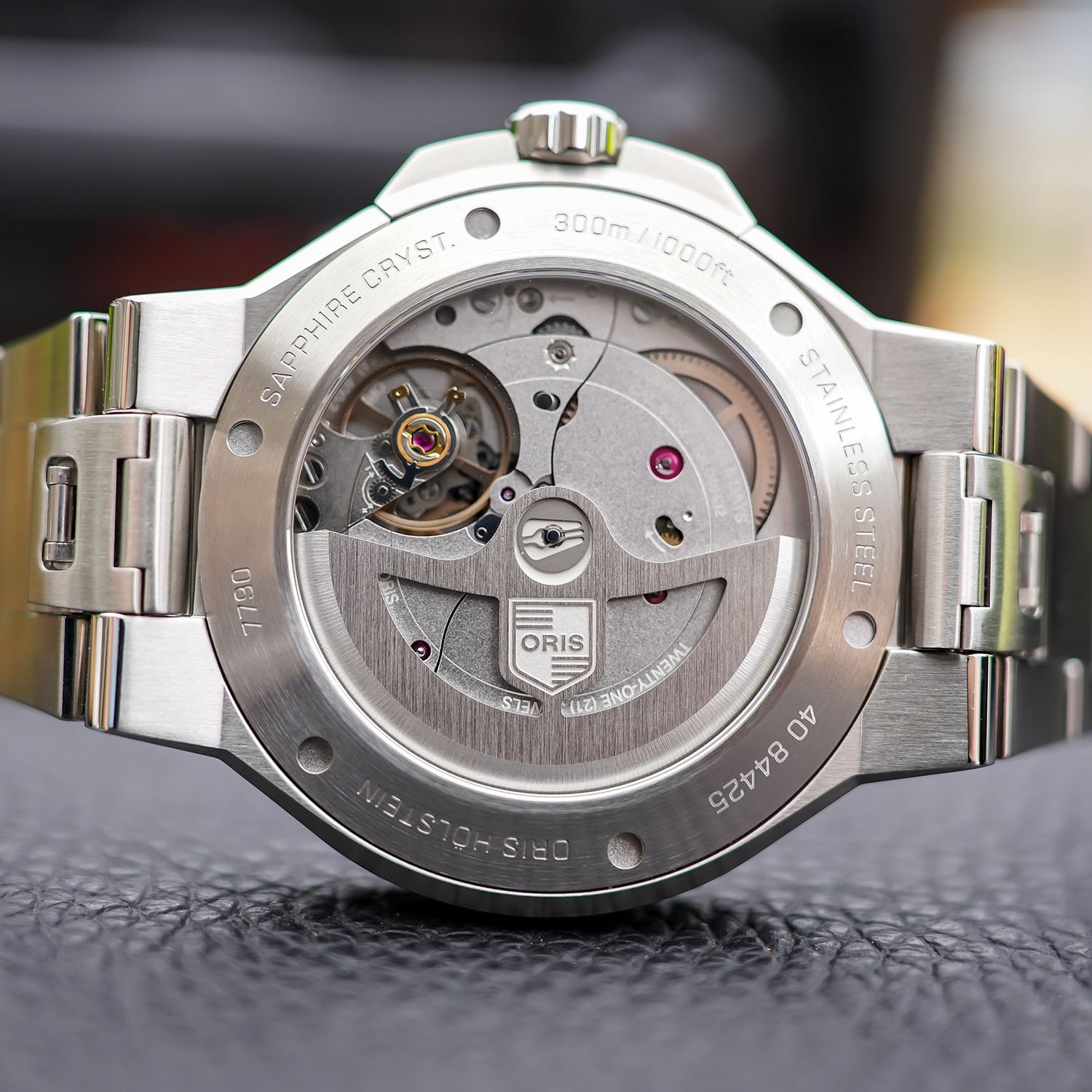
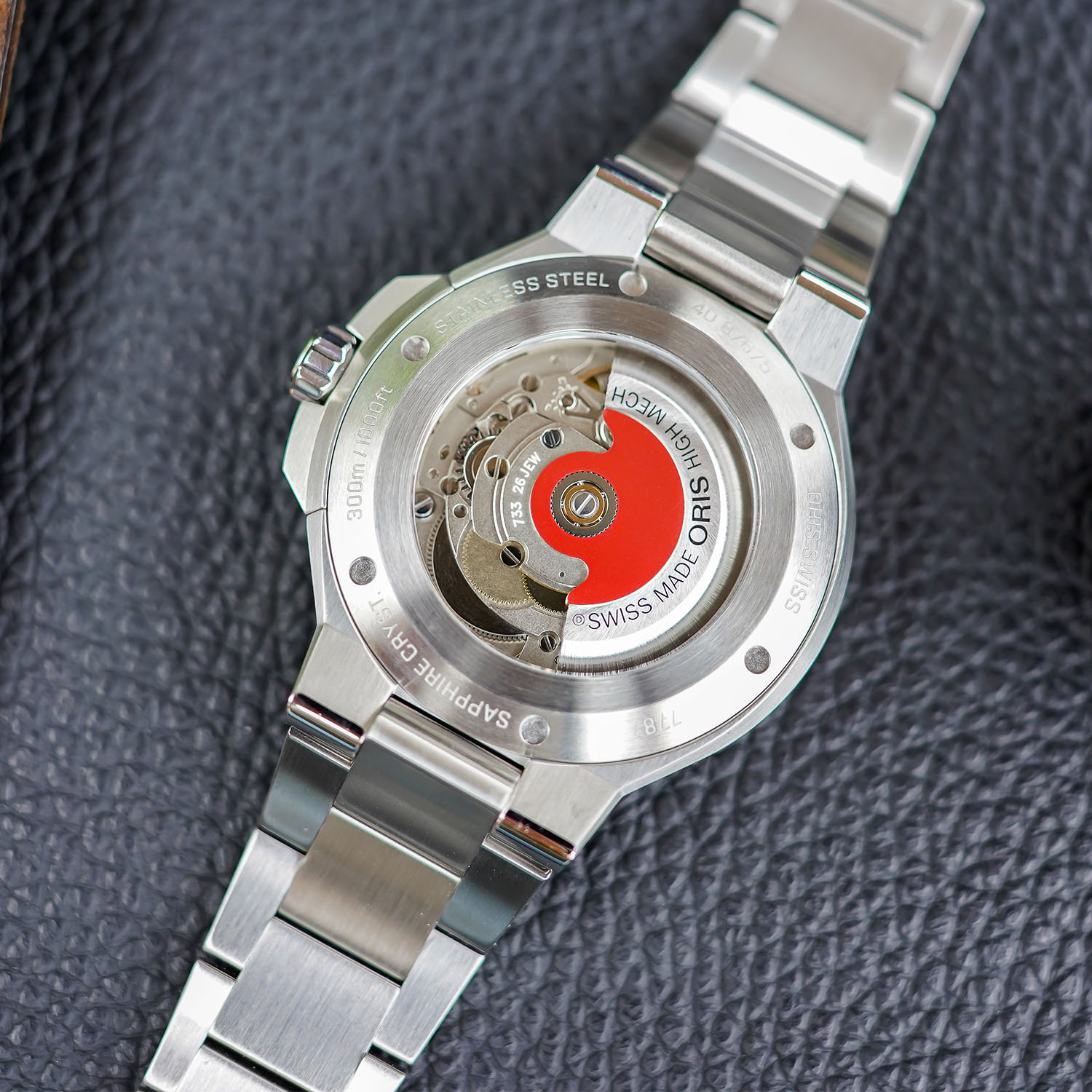
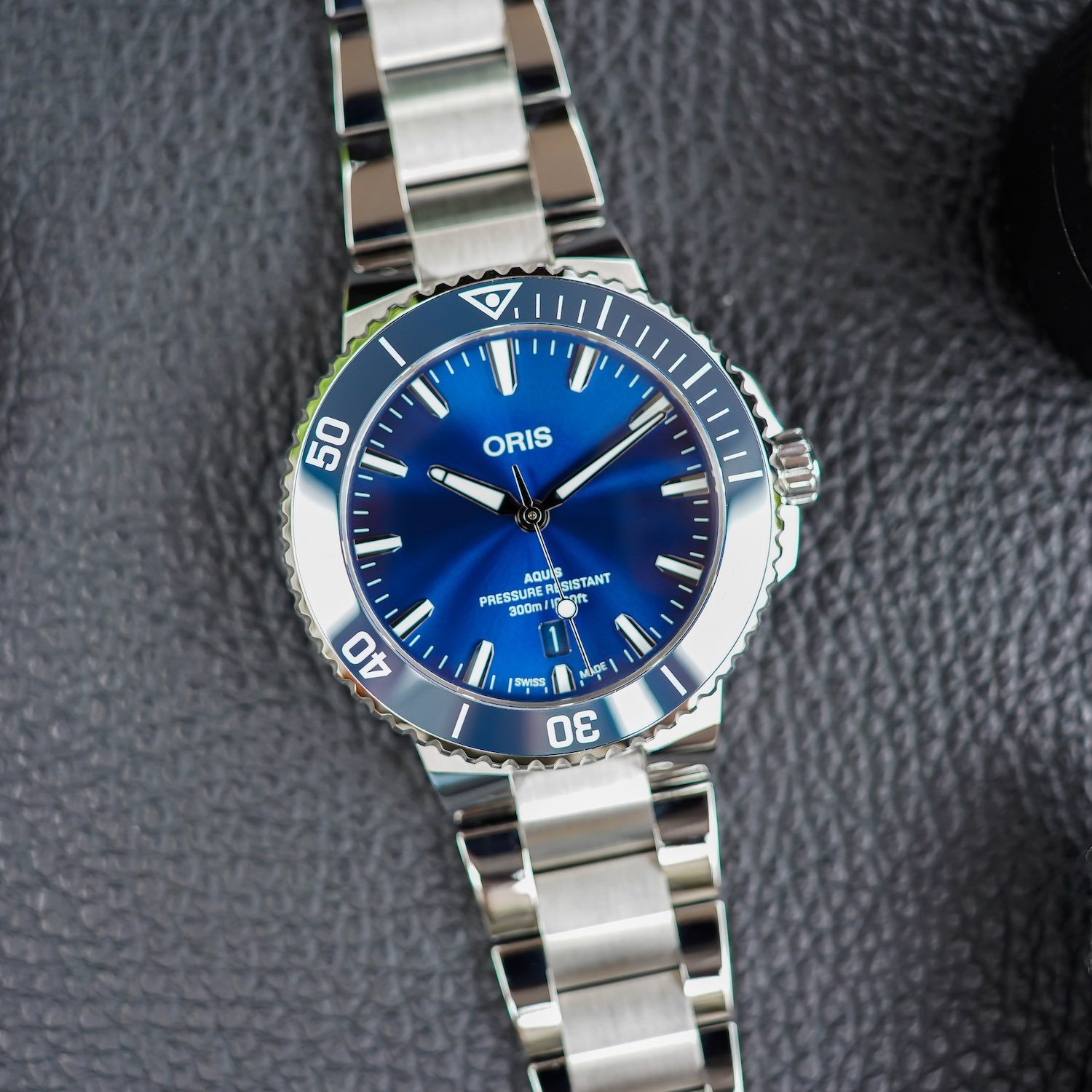
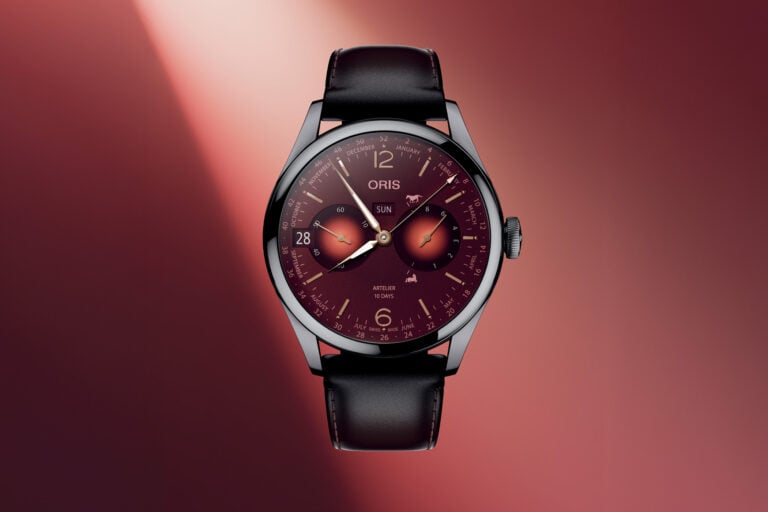
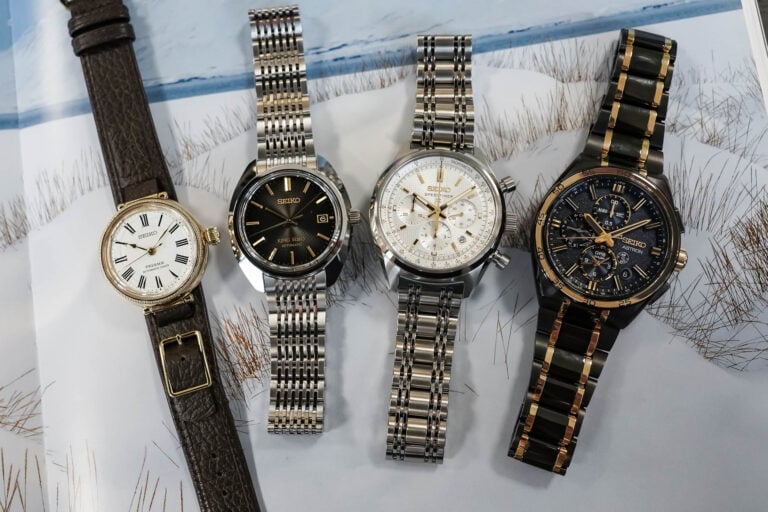
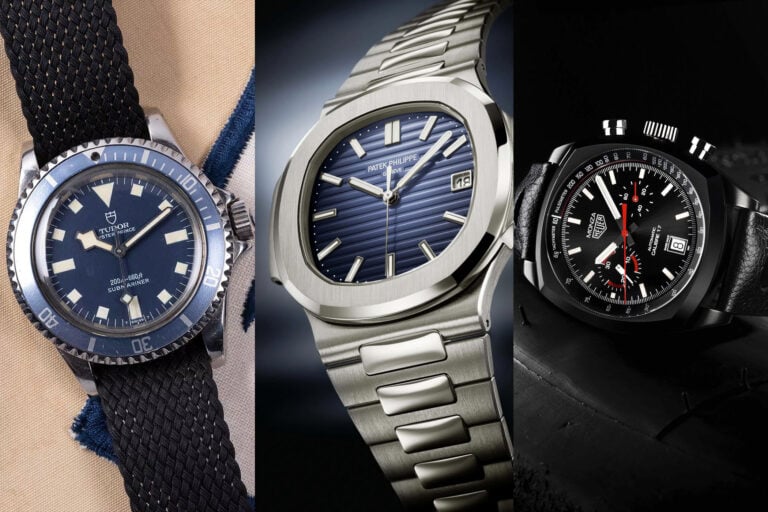
4 responses
I dont get why they made the links of the bracelet longer. isnt it more comfortable when they are shorter because it gives you better articulation? at least seiko changed it to the opposite recently with their updateed spb453 from the old spb143.
I prefer the older wider font – it looks more ‘Oris’ to me.
Otherwise, the improvements are welcome.
Movement Cal. 400 in Oris Aquis is factory defective. It breaks down very often. Mine every six months. For the fifth time already
Is there still some kind of embargo on the quick-adjust clasp? I’ve seen multiple reviews now where it’s mentioned and shown from the outside, but nobody has yet shown how it works. It’s very, very odd.